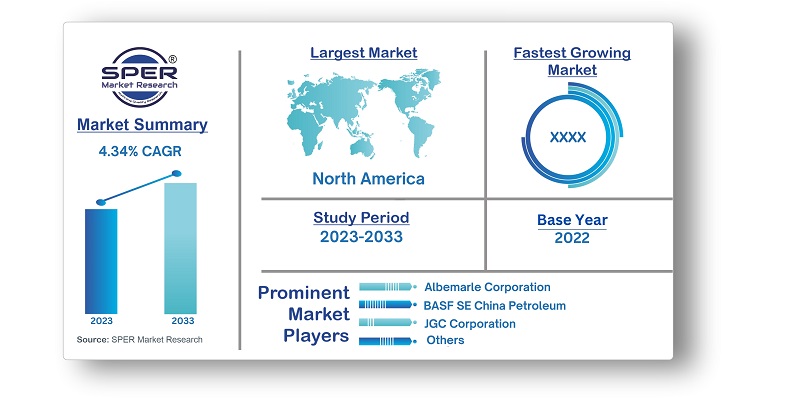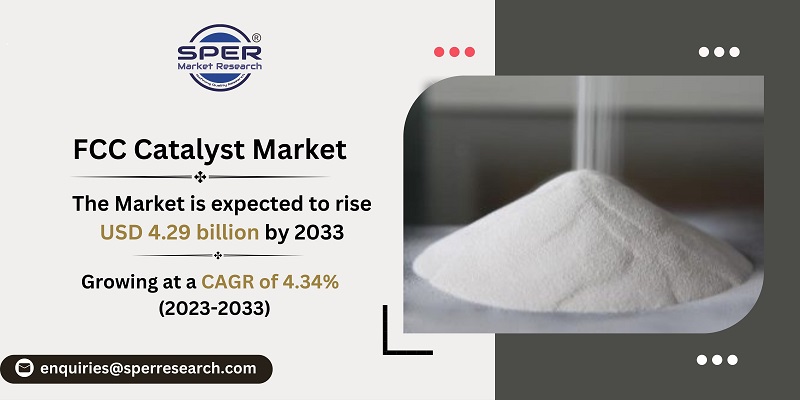
FCC Catalyst Market Growth, Size, Revenue, Trends, Demand and Future Opportunities Till 2033
FCC Catalyst Market Size- By Product, By Technological Configuration, By Application- Regional Outlook, Competitive Strategies and Segment Forecasts to 2033
| Published: Dec-2022 | Report ID: CHEM2214 | Pages: 1 - 236 | Formats*: |
| Category : Chemical & Materials | |||
- Refining Capacity and Demand: The demand for FCC catalysts is closely tied to the refining capacity and the demand for petroleum products. As global energy consumption continues to grow, the need for refining heavier crude oil and maximizing the production of lighter products such as gasoline and olefins increases. Higher refining capacities and increasing demand for petroleum products drive the demand for FCC catalysts.
- Technological Advancements: Advances in catalyst technology are significant drivers of the FCC Catalyst market. Catalyst manufacturers invest in research and development to improve the performance, selectivity, and stability of FCC catalysts. Innovative catalyst formulations that offer higher conversion rates, increased product yields, and enhanced properties such as sulphur removal and gasoline octane enhancement are in demand.


| Report Metric | Details |
| Market size available for years | 2019-2033 |
| Base year considered | 2022 |
| Forecast period | 2023-2033 |
| Segments covered | By Type, By Application. |
| Regions covered | Asia Pacific, Europe, Middle East and Africa, North America, Latin America |
| Companies Covered | Albemarle Corporation, BASF SE China Petroleum & Chemical Corporation, Clariant AG, Haldar TopSEOs A/S, JGC Corporation, W. R. Grace & Co.-Conn, Others. |
- Refineries and Petrochemical Companies
- Catalyst Manufacturers
- Research Institution and Academia
- Market Analysts and Consultants
- Professional Cleaners
| By Type: |
|
| By Application : |
|
- Global FCC Catalyst Market Size (FY’2023-FY’2033)
- Overview of Global FCC Catalyst Market
- Segmentation of Global FCC Catalyst Market By Type (Gasoline Sulphur Reduction, Maximum Light Olefins Conversion, Maximum Middle Distillation, Maximum Bottom Conversion, Others)
- Segmentation of Global FCC Catalyst Market By Application (Vacuum Gas Oil, Residues, Others)
- Statistical Snap of Global FCC Catalyst Market
- Expansion Analysis of Global FCC Catalyst Market
- Problems and Obstacles in Global FCC Catalyst Market
- Competitive Landscape in the Global FCC Catalyst Market
- Impact of COVID-19 and Demonetization on Global FCC Catalyst Market
- Details on Current Investment in Global FCC Catalyst Market
- Competitive Analysis of Global FCC Catalyst Market
- Prominent Players in the Global FCC Catalyst Market
- SWOT Analysis of Global FCC Catalyst Market
- Global FCC Catalyst Market Future Outlook and Projections (FY’2023-FY’2033)
- Recommendations from Analyst
1.1. Scope of the report1.2. Market segment analysis
2.1. Research data source2.1.1. Secondary Data2.1.2. Primary Data2.1.3. SPER’s internal database2.1.4. Premium insight from KOL’s2.2. Market size estimation2.2.1. Top-down and Bottom-up approach
2.3. Data triangulation
4.1. Driver, Restraint, Opportunity and Challenges analysis4.1.1. Drivers4.1.2. Restraints4.1.3. Opportunities4.1.4. Challenges4.2. COVID-19 Impacts of the Global FCC Catalyst Market
5.1. SWOT Analysis5.1.1. Strengths5.1.2. Weaknesses5.1.3. Opportunities5.1.4. Threats5.2. PESTEL Analysis5.2.1. Political Landscape5.2.2. Economic Landscape5.2.3. Social Landscape5.2.4. Technological Landscape5.2.5. Environmental Landscape5.2.6. Legal Landscape5.3. PORTER’s Five Forces5.3.1. Bargaining power of suppliers5.3.2. Bargaining power of buyers5.3.3. Threat of Substitute5.3.4. Threat of new entrant5.3.5. Competitive rivalry5.4. Heat Map Analysis
6.1. Global FCC Catalyst Market Manufacturing Base Distribution, Sales Area, Product Type6.2. Mergers & Acquisitions, Partnerships, Product Launch, and Collaboration in Global FCC Catalyst Market
7.1. Global FCC Catalyst Market Value Share and Forecast, By Type, 2023-20337.2. Gasoline Sulphur Reduction7.3. Maximum Light Olefins Conversion7.4. Maximum Middle Distillation7.5. Maximum Bottom Conversion7.6. Others
8.1. Global FCC Catalyst Market Value Share and Forecast, By Application, 2023-20338.2. Vacuum Gas Oil8.3. Residue8.4. Others
9.1. Global FCC Catalyst Market Size and Market Share
10.1. Global FCC Catalyst Market Size and Market Share By Type (2019-2026)10.2. Global FCC Catalyst Market Size and Market Share By Type (2027-2033)
11.1. Global FCC Catalyst Market Size and Market Share By Application (2019-2026)11.2. Global FCC Catalyst Market Size and Market Share By Application (2027-2033)
12.1. Global FCC Catalyst Market Size and Market Share By Region (2019-2026)12.2. Global FCC Catalyst Market Size and Market Share By Region (2027-2033)12.3. Asia-Pacific12.3.1. Australia12.3.2. China12.3.3. India12.3.4. Japan12.3.5. South Korea12.3.6. Rest of Asia-Pacific12.4. Europe12.4.1. France12.4.2. Germany12.4.3. Italy12.4.4. Spain12.4.5. United Kingdom12.4.6. Rest of Europe12.5. Middle East and Africa12.5.1. Kingdom of Saudi Arabia12.5.2. United Arab Emirates12.5.3. Rest of Middle East & Africa12.6. North America12.6.1. Canada12.6.2. Mexico12.6.3. United States12.7. Latin America12.7.1. Argentina12.7.2. Brazil12.7.3. Rest of Latin America
13.1. Albemarle Corporation13.1.1. Company details13.1.2. Financial outlook13.1.3. Product summary13.1.4. Recent developments13.2. BASF SE13.2.1. Company details13.2.2. Financial outlook13.2.3. Product summary13.2.4. Recent developments13.3. China Petroleum & Chemical Corporation13.3.1. Company details13.3.2. Financial outlook13.3.3. Product summary13.3.4. Recent developments13.4. Clariant AG13.4.1. Company details13.4.2. Financial outlook13.4.3. Product summary13.4.4. Recent developments13.5. Haldar TopSEOs A/S13.5.1. Company details13.5.2. Financial outlook13.5.3. Product summary13.5.4. Recent developments13.6. JGC Corporation13.6.1. Company details13.6.2. Financial outlook13.6.3. Product summary13.6.4. Recent developments13.7. W. R. Grace & Co.-Conn.13.7.1. Company details13.7.2. Financial outlook13.7.3. Product summary13.7.4. Recent developments13.8. Others
SPER Market Research’s methodology uses great emphasis on primary research to ensure that the market intelligence insights are up to date, reliable and accurate. Primary interviews are done with players involved in each phase of a supply chain to analyze the market forecasting. The secondary research method is used to help you fully understand how the future markets and the spending patterns look likes.
The report is based on in-depth qualitative and quantitative analysis of the Product Market. The quantitative analysis involves the application of various projection and sampling techniques. The qualitative analysis involves primary interviews, surveys, and vendor briefings. The data gathered as a result of these processes are validated through experts opinion. Our research methodology entails an ideal mixture of primary and secondary initiatives.



Frequently Asked Questions About This Report
PLACE AN ORDER
Year End Discount
Sample Report
Pre-Purchase Inquiry
NEED CUSTOMIZATION?
Request CustomizationCALL OR EMAIL US
100% Secure Payment






Related Reports
Our Global Clients
Our data-driven insights have influenced the strategy of 200+ reputed companies across the globe.




















